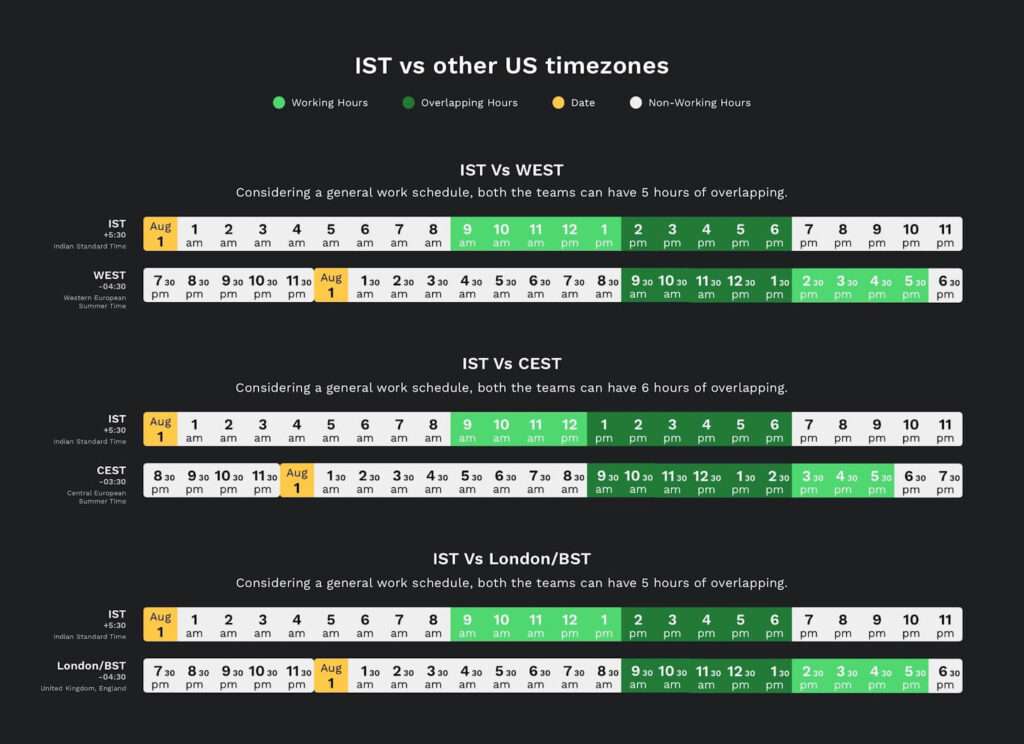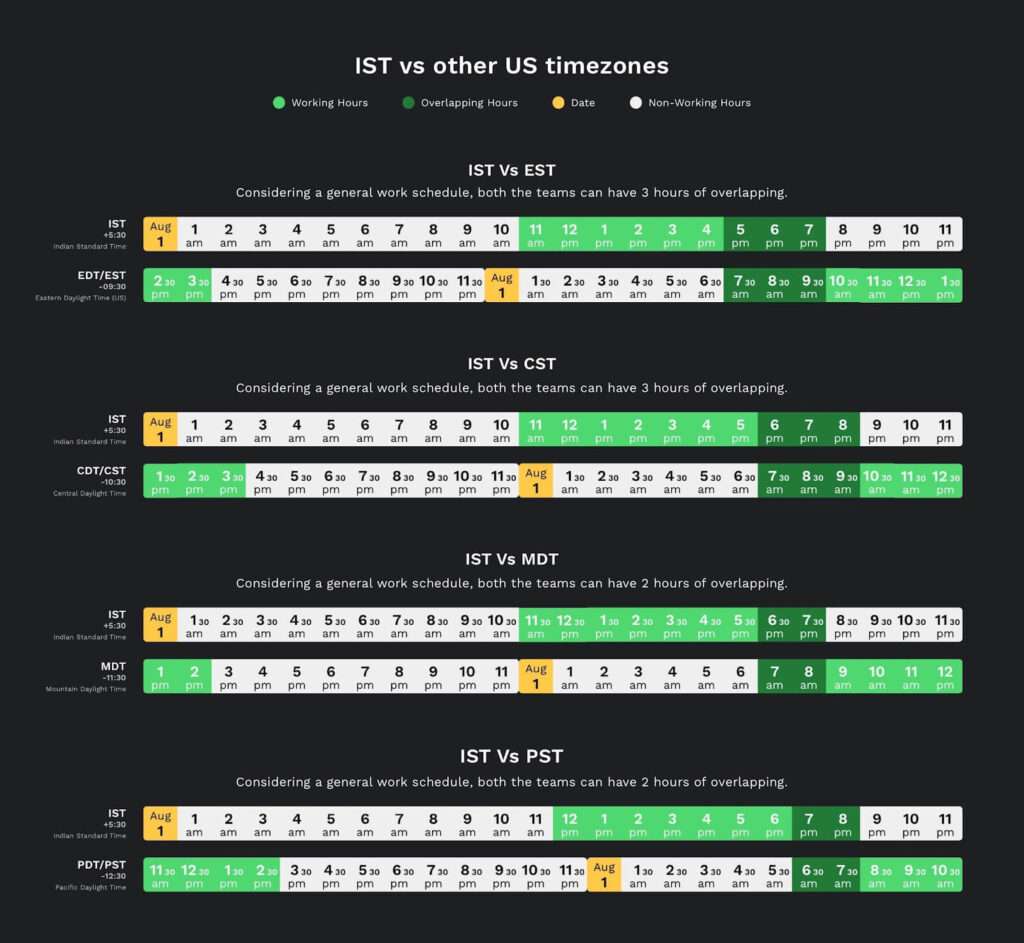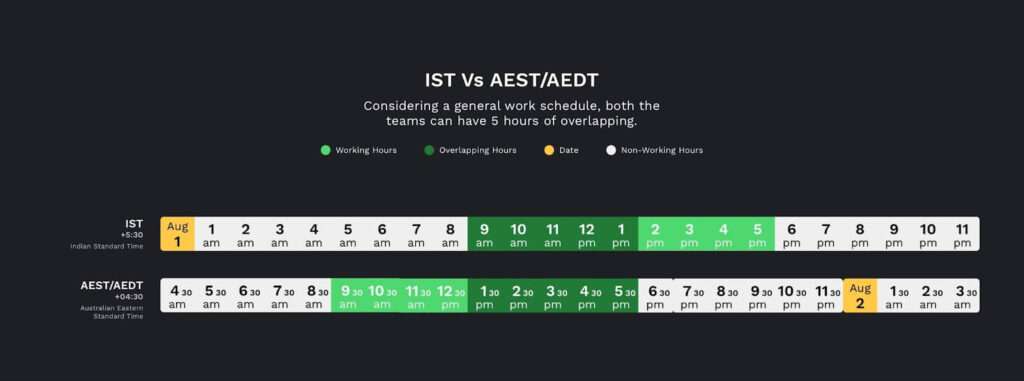Are you experiencing challenges like insufficient overlapping time or longer turnaround times due to timezone differences with your offshore development team? Or, If you’re considering hiring an offshore application development team but are hesitant due to the challenges mentioned above?
To effectively resolve these issues, it is necessary to address the challenges you will come across due to timezone differences with your offshore application development team.
Gone are the days when hiring an offshore application development team was met with scepticism. In today’s rapidly evolving technological landscape, businesses recognise the immense benefits of partnering with skilled professionals from across the globe.
With over twelve years of experience as a custom software development company, we at Mallow have catered to clients across different time zones, including USA, UK, Canada, Australia etc. Our team comprises seasoned experts who have completed numerous projects with clients from different countries with diversified cultures. Our commitment to delivering exceptional results sets us apart and keeps our clients returning for more.
This article will provide you with insights into the common challenges related to timezone differences that are often encountered when working with an offshore development team. By reading this, you will understand how to deal with these problems efficiently and effectively, allowing for smoother collaboration and project execution.
Common problems faced due to timezone differences while working with offshore application development teams
- Reduced productivity
- Slower turnaround time
- Coordination challenges
- Cultural and language barriers
Timezone differences can significantly impact collaborative efforts, particularly when working with global teams or across geographically dispersed locations. These disparities in time can lead to communication delays and coordination challenges and hinder real-time interactions. Effective strategies, such as flexible scheduling, clear communication protocols, and collaboration tools, are essential to mitigate the potential disruptions caused by timezone variations.
By implementing the tips shared below, you can witness improved collaboration, seamless communication, and enhanced productivity in your application development process.
Encouraging team members to acknowledge and appreciate each other’s working hours and personal commitments can create a supportive atmosphere. This includes being mindful of scheduling meetings at reasonable times for all participants and avoiding urgent requests during non-working hours.
Emphasising asynchronous communication, where possible, can also alleviate the pressure of immediate responses and allow team members to be more productive within their time zones.
8 tips to handle the timezone differences while working with an off-shore application development team.
1.Establish overlapping working hours
By ensuring a considerable overlap, teams from different time zones can effectively address urgent concerns, conduct virtual meetings, and maintain a seamless workflow. This approach promotes better coordination and understanding between teams, enhances overall productivity, and accelerates project development.
Let’s consider an application development team that operates from India. It has clients across different time zones. Below mentioned comparisons will give you a clear idea of how the overlapping hours between both teams could be handled efficiently and effectively.




Please note that the suggested template for overlapping working hours between teams from different time zones is meant to provide a framework for managing collaboration effectively. The actual working hours and overlapping hours will indeed depend on various factors, including project requirements, team dynamics, and individual preferences. Flexibility is key, and you should tailor your approach to suit your specific needs while ensuring smooth communication and coordination.
2.Leverage asynchronous communication
Asynchronous communication allows team members to respond and provide input at their own pace, regardless of time zone differences. By using tools like project management software, email, or messaging platforms, team members can share updates, questions, and feedback without the need for immediate responses. This approach ensures that important information is available to everyone, reducing misunderstandings and enabling team members to focus on tasks without interruptions.
By leveraging asynchronous communication, team members can share information and collaborate effectively without waiting for others to be online simultaneously.
Below mentioned is a table that would give you an overview of how the communication process with your application development team could be handled efficiently.
| Communication Tool | Purpose of Communication |
| Formal communication, sharing project updates, documentation, and attachments. | |
| Slack | Real-time messaging, team collaboration, file sharing, and discussions. |
| Microsoft Teams | Video calls, meetings, instant messaging, file sharing, and collaboration. |
| Jira | Issue tracking, task management, and team collaboration on project development. |
| Confluence | Collaborative workspace for creating and sharing project documentation, meeting notes, and knowledge base. |
| GitHub | Version control, code collaboration, and tracking software issues and enhancements. |
| Trello | Project management, task tracking, and team collaboration using boards and cards. |
| Zoom | Video conferencing, virtual meetings, screen sharing, and webinars. |
| Google Docs | Real-time collaborative editing and sharing of documents, spreadsheets, and presentations. |
| Asana | Project and task management, team collaboration, and progress tracking. |
3.Promote a culture of documentation
Encouraging thorough documentation ensures that important decisions, discussions, and project updates are recorded and easily accessible to all team members. This reduces the chances of miscommunication and allows new team members to get up to speed quickly.
The ideal platforms for this purpose are project management tools like Jira or Asana, which allow teams to create and update tasks, attach relevant documents, and track progress.
The significance of comprehensive documentation becomes even more apparent in the absence of team members. When a team member is unavailable for reasons such as vacations, events, or turnover, accessing well-documented information can prove invaluable. Colleagues can step in with a clear understanding of the project’s history, decisions made, and ongoing tasks, ensuring that the project’s momentum is maintained.
- Apart from this, version control systems like Git and code hosting platforms like GitHub or GitLab are excellent for documenting technical decisions and updates within the codebase. Internal wikis or knowledge bases can also be utilised to provide comprehensive documentation on broader project discussions and decisions.
4.Hold regular meetings and status updates
While asynchronous communication is valuable, regular meetings and status updates are essential for real-time discussions and addressing any immediate concerns. These meetings help the team stay on track, discuss progress, challenges, and updates, and allow team members to raise issues or ask questions directly. Regular check-ins also help build rapport and foster open communication among team members.
Below is a table that will give you a clear idea of:
- The different types of meetings your application development process will go through
- What could be its ideal frequency
- What are the types of resources required
- What is the purpose of the call you are about to go with.
| Meeting type | Frequency | Type of resources attending that meeting | Purpose of the call |
| Requirement discussion | Twice per week | Product Owner with Stakeholders | To discuss the requirements and clarify queries of the current task and to discuss the requirements for the tasks in backlog |
| Module-wise weekly call | Once per week | Development Team with Technical Manager | To discuss the technical approaches and work plan, discuss any challenges or blockers and discuss the timelines |
| Sprint Review and Planning | Bi-weekly | Development Team, Scrum Master, and Product Owner | Review the works completed in an earlier sprint and plan the tasks for the next sprint considering the priority of the tasks and the development team’s capacity. |
| Daily Scrum | All weekdays | Development Team, Scrum Master, Product Owner, | To discuss the progress of the works committed for the sprint, raise about any challenge the developer faces so others can share their ideas and sharing their learnings |
| Squad’s weekly call | Once per week | Development Team with Technical Manager | Review the technical standards followed in the squad and review the technical metrics associated with the squads to ensure the standard and the best practices. |
| Sprint Retrospective | Bi-weekly | Development Team, Scrum Master, Product Owner | To get the feedback from the completed sprint on, 1. What went well, helping them to complete the task as agreed? 2. What issues did they face that blocked or interrupted their work? 3. What has to be improved or changed to help the team progress better? 4. Any questions in the process? |
| Backlog refinement Meeting | Once perweek | Product Owner with Stakeholders | Review the tasks in the backlog, plan the order in which the tasks have to be taken for work and agree with the timelines for the tasks. |
| On-demand meetings | Whenever required |
Project Manager | Emergency feature Requests/critical feature/demo |
| Addition of a new team member/availing new service | |||
| Timeline change requests | |||
| Cost change requests | |||
| Escalation |
Please note that not all projects demand every type of meeting (such as sprint planning, sprint retrospective, sprint review, or squad planning meetings). The need for these meetings varies based on the nature of the project, team dynamics, and organisational culture. Ensure the list of meetings you finally select is relevant and essential for your application development process.
5.Design an incident response plan.
A well-defined plan and prioritisation strategy are essential to handle these issues efficiently and minimise any negative impact on the application and its users.
Here’s a step-by-step guide on how you can execute your response plan.
Step 1: Identify severity levels – Define severity levels based on the potential impact it has on the application users. For example, classify issues as Critical, High, Medium, and Low based on their severity and priority.
- Critical issues require immediate attention, and resolution should be prioritised.
- High-severity issues have a substantial impact on the application’s functionality or security but may not render it entirely unusable. High-severity issues demand swift attention and should be addressed within a few hours to a day to mitigate potential risks and restore proper functionality.
- Medium-severity issues have a noticeable impact on certain aspects of the application but do not pose significant risks to data integrity or security. While they are not as urgent as critical or high-severity issues, they still require timely resolution, typically within a few days to a week, to maintain the overall stability and performance of the application.
- While low-severity issues are lower in priority, they should not be ignored, and resolution can be scheduled according to available development resources and priorities, typically within a week or two.
In certain situations, low-severity issues can also elevate their importance more than expected. For instance, consider a UI issue in the application that obstructs the display of the brand name. While this may not severely impact the application’s functionality, it becomes a high-priority concern due to its direct relation to the brand and business reputation. Addressing this issue promptly is crucial to maintaining the brand’s image and ensuring a positive user experience.
Below mentioned table will give you an overview of what the different categories under which issues could typically be categorised based on their severity and priority, what is the typical timeframe for resolution, what is the procedure to raise it and who will be the point of contact for the same.
| Severity | Priority | Timeframe for resolution | How to raise | Point of contact |
| Critical | High | Within 4 hrs | Call or High-Priority escalation through ticketing system | Project Manager |
| Medium | Within 12 hrs | |||
| High | Medium | Within 24 hours | Email or Regular ticket submission | |
| Low | ||||
| Medium | Low | Within 2 days | Ticket Submission | |
| Low | Minor | Within 4 days |
Before commencing the project, it is essential to engage in discussions with the application development team regarding the severity levels of issues, such as critical, high, medium, and low. Deciding on the appropriate mode of communication and establishing clear points of contact will ensure a seamless and effective approach to addressing potential problems throughout the development process.
Ensuring that these procedures for addressing off-timezone issues are clearly communicated, documented, and finalised well before project commencement will establish a solid foundation for a collaborative and responsive partnership.
Step 2: Prioritise issues – Using the predefined severity levels, prioritise the issues based on their potential impact on the application and the user experience. Critical issues should be addressed with the highest priority.
Designate roles and responsibilities for each team member. Keep all stakeholders, including the development team, management, and clients, informed about the issue resolution progress. Provide regular updates on the status of each problem.
Critical and high-severity issues demand immediate attention, so experienced team members could be assigned to tackle them promptly. Medium-severity issues should be addressed by competent developers within a defined timeframe. Low-severity issues, though lower in priority, are still scheduled for resolution according to available resources and project priorities.
Step 3: Continuous monitoring – After the initial response, implement continuous application monitoring to ensure the issues are fully resolved and no new problems have emerged. Monitoring tools like New Relic and Sentry, provide real-time insights into application performance and error tracking. This proactive approach will help you to maintain a stable and reliable system, minimising the risk of potential future disruptions and ensuring a seamless user experience.
Step 4: Post-incident review – Conduct a post-incident review to analyse the root causes of severe issues and identify ways to prevent similar problems in the future.
It’s essential to acknowledge that technical challenges can arise at any hour, and your application development team should be well-prepared to provide swift and efficient resolutions. It’s imperative to emphasise these expectations during discussions with the potential application development team you consider hiring.
6.Be mindful of cultural differences
Working with an application development team that has members from diverse cultural backgrounds requires understanding and respect for different communication styles and norms. Being tolerant of cultural differences can prevent misunderstandings and conflicts. Awareness of different cultural perspectives enhances collaboration and ensures all team members feel valued and heard.
7.Promote a sense of team cohesion
Building strong camaraderie and collaboration among team members is crucial to maintaining effective communication. Encourage online and in-person team-building activities (if possible) to foster a positive team environment. A cohesive team is likelier to communicate openly, share ideas, and collaborate smoothly.
8.Be flexible and accommodating
- By being flexible with work schedules, both teams can find common meeting times or work hours to collaborate effectively. Finding an overlap in work hours allows for real-time communication, quicker issue resolution, and faster decision-making.
- Flexibility in work hours enables better utilisation of resources and skills within the offshore team. It ensures that team members work during their most productive hours, which can positively impact the quality and efficiency of deliverables.
- By accommodating varying work schedules, all team members, regardless of their time zone, can actively participate in discussions, meetings, and decision-making processes. This inclusivity builds a sense of ownership and involvement among team members.
For example, when planning and scheduling important meetings, it’s essential to consider the holidays of both teams, including those in the offshore location, to ensure inclusive participation and effective collaboration.
How to hire the right application development team to build your application.
Handling timezone differences is crucial when working with an offshore application development team. The art lies in maintaining efficient communication, seamless collaboration, and timely project deliveries. By addressing these differences proactively, the team can leverage overlapping working hours to hold productive discussions and quickly address issues.
Effective timezone management promotes global teamwork and creates a more inclusive and connected work environment, ultimately leading to successful project outcomes and strengthened business relationships.
Selecting the appropriate application development team holds the utmost significance for any organisation striving to build effective and impactful software solutions.
Planning to hire a new application development team to build your application? Check out our step by step guide on how to hire the right application development team to carry out your application development process in the best possible way.
Still, you feel as if we can guide you out with something? Feel free to reach out to our team.
Your queries, our answers
The offshore development process is the practice of outsourcing software development tasks to teams located in different countries, typically to take advantage of cost savings and access a broader talent pool. It involves steps like requirement gathering, service provider selection, development, quality assurance, and post-deployment support, all managed through clear communication and collaboration between the client and offshore team.
We use a combination of communication tools like Slack, Microsoft Teams, Skype, and Google Meet for video meetings, and Jira for task management to ensure seamless collaboration and effective communication between offshore teams.
To handle urgent issues outside of working hours, we have a dedicated support system in place, along with clearly documented emergency protocols. This includes an on-call or rotating schedule and defined escalation procedures to ensure that any critical issues are addressed promptly. Even when teams are in different time zones, we ensure timely resolution by following these established processes, enabling continuous support and quick action when needed.
At Mallow, we understand the importance of managing time zone differences effectively in software outsourcing. Here are some strategies we use:
- Implement overlapping working hours to facilitate real-time communication between teams in different time zones.
- Use project management and collaboration tools to ensure seamless communication and task tracking across time zones.
- Set clear expectations for response times and deadlines to maintain productivity and minimize delays.
Scheduled meetings, written progress reports, and automated tools help keep all clients and team members informed of the project's status, no matter the time zone.
Using automated testing tools, having dedicated quality assurance teams, and holding regular review sessions help maintain consistent quality despite the time zone differences.
Establishing regular check-ins, using collaboration tools, and maintaining transparency through shared documents help bridge the gap between onshore and offshore teams.
Time zone differences, cultural barriers, and communication gaps can be significant challenges when working with offshore teams, but they can be managed with proper planning and tools.
Author
Kamalavel Rajendran
Kamal is the CEO of Mallow Technologies, a visionary leader with a mission to harness the potential of technology for tackling a variety of business challenges. He established the company with the objective of delivering tailored software solutions that address the wide array of issues encountered by businesses. He firmly believes that technology, empowers businesses to make informed decisions and promotes growth from every angle. In his leisure time, Kamal exhibits a remarkable passion for the game of tennis, immersing himself fully in the game. Furthermore, beyond the confines of the tennis court, his unwavering enthusiasm for innovation is apparent as he stays at the forefront of the latest developments in the realms of both business and technology. His dedication to merging the worlds of business and technology positions him as a dynamic presence in the industry, continually seeking inventive solutions to propel companies towards new horizons.



